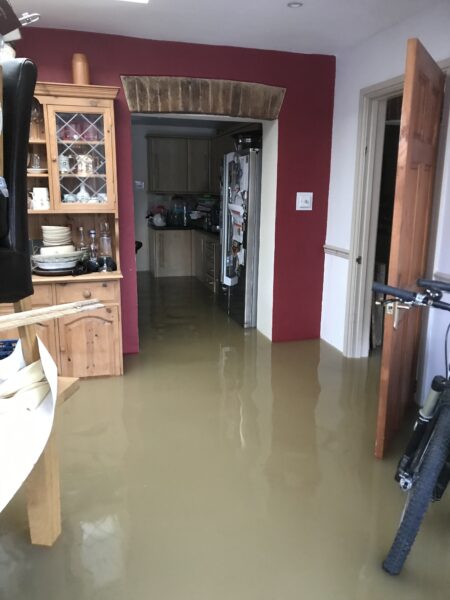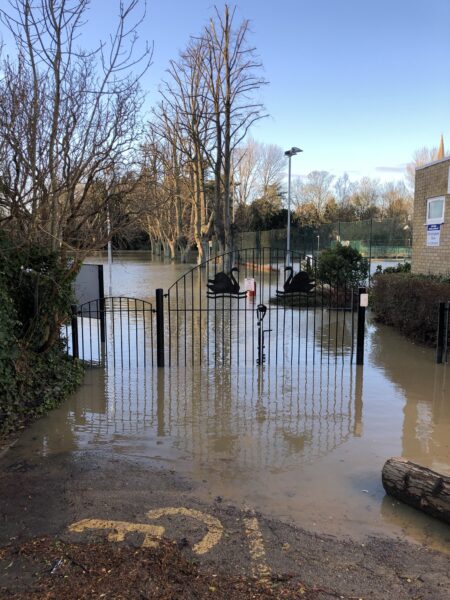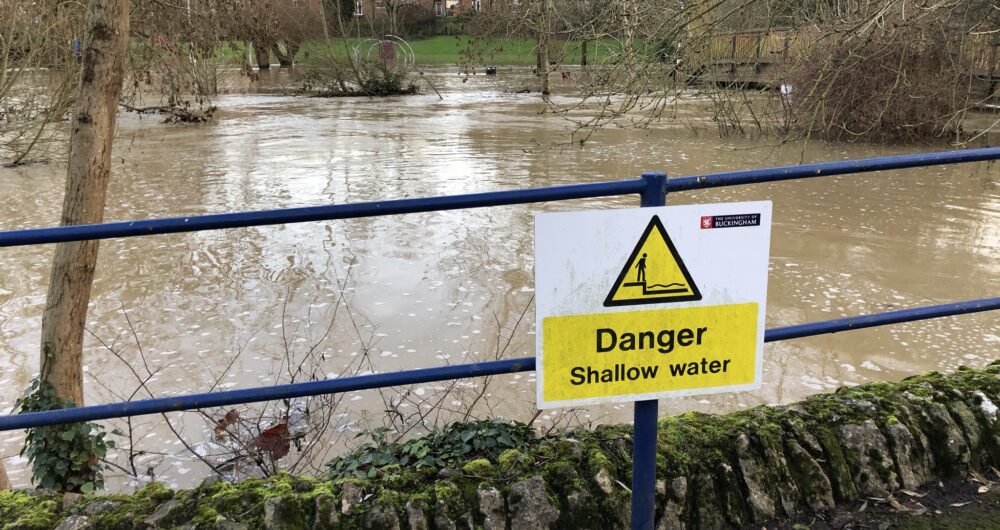Flooding is nothing new to Buckingham, a town built on the banks of the Great River Ouse. The most recent major one, the day before Christmas Eve in 2020, damaged 75 homes and five businesses.
This led to a review of the local flood plan by Buckinghamshire Council, who are the Lead Local Flood Authority, which requires them to “develop, maintain, apply and monitor a strategy for local flood risk management in its area”.
The UK experienced 55 per cent more rainfall than an average April this year – and the wettest April since 2012, according to statistic from the Met Office
But despite this ever-present threat, it appears nothing has been done to tackle the issue, a fact that will come as no surprise to those who have witnessed the damage over the years.
Bob Gregory, a resident in Buckingham for over 25 years, was flooded for the third time in 2020. He said: “We did everything that we could to prevent the water coming in, but you can’t. It was up to my waist in the morning. The kitchen, dining room, downstairs toilet, lounge, utility area, bottom of the stairs was all covered.
“It’s the hopelessness, when you see the water in the university playing fields, trickle into your garden, which is a lengthy piece of land and there is nothing you can do. Absolutely nothing to stop the relentless surge of water that hits the back of your house.
“From the previous times, we were given flood defences by the council. You might as well have a fag paper there because it doesn’t stop anything.”

What is being done?
One of the causes of the increased rate of flooding is the development of houses. It’s not that housing developments are bad for the town, they bring extra business to restaurants and cafes in Buckingham, but without providing their own drainage and sewage, they are increasing the pressure on Buckingham’s already at-capacity drainage works.
Town Councillor Jon Harvey, a member of Buckingham’s planning committee said: “The town council always looks at every planning application for big and small applications and thinks of the flooding risks that come with them. We either pass no comment on the application to the shire council or we raise our objections to it.
“Any new development on the hills around the river will yield more water, it runs off the roads and the roofs. When Page Hill was built a drainage scheme was put it place that meant water should have run into the culvert that travels down the eastern bypass.
“Something happened, we don’t know what, that means the water now runs into Linden Village. At some point that needs to be fixed.
“As you know, the Osier Way development to the south of the industrial estate, was approved by the shire council, without any plans of how the water would be connected to the houses that are built or how the sewage would taken away.”
The council have also developed an app, which alerts residents and businesses to rising waters, giving them time to prepare themselves.
For residents like Bob, this seems inadequate. He said: “For the council to turn around after the last flood and to say ‘Don’t worry, we’ve created an app.’ Great! I’ll hold my phone at the rising water and see how good the app is. I don’t need someone to tell me when the water is rising, I can look outside my window.”
Jake Lynch, owner of The Motor Spa, a valeting and detailing company was flooded in June 2023, as a result of the sewage drains overflowing. He had over two feet of water in his business, costing him £5,000 worth of damage to his equipment.

He said: “We’ve never had any help from councils, we’ve emailed and filled out questionnaires that have been delivered but never heard anything back.
“The sewage drains are man enough to cope with an expanding town. We’ve had the drains cleared and raised up, and put in flood gates, but this was done by our landlord and out his pocket, in an attempt to protect his site.
“Anglian Water came out to clear the drains and they said they weren’t strong enough to cope with the town. So we’re a bit stuck about what is going to happen next.”
A growing population
The town’s population has risen by over 2,000 in the past decade, according to the National Censuses.
County Councillor Robin Stuchbury shares the frustrations of residents and business owners but believes that development does not need to increase the pressure on the water works.
“Development can be the answer, development can offer alleviations and add no more to it, that means we have to take sewage and drainage away from the town centre.
“When Lace Hill was built, the owner of the land had to put a brand new sewage system in down to the sewage works in Stony Stratford so that didn’t add to it, it resolved it.
“There are two sorts of drainage. There’s the drainage, which is in estates, which we have problems within Western Avenue, Badgers, on the Bourton Road and Gawcott road. We recently solved a problem on the London Road.
“This is a combined question, some of it is due to the owners of the land not maintaining their area. Some of it is because the council haven’t got round to it because it’s very complicated, hugely expensive and they’re trying all other options first.”
Drainage a priority for new homes
Housing developments new to the town are built with the nationally required SuDS scheme (Sustainable drainage systems).
They are effectively ponds built where run-off water, caused by the increased concrete, can run into.
They provide an alternative to the direct channelling of surface water through networks of pipes and sewers to nearby watercourses.
An example of this can be at the new St Rumbold’s Estate, on Tingewick Road.
There is still a lot that needs to be done in Buckingham to reduce the rate of flooding. Events that were described as one in a hundred-year events are now occurring once every ten-years and more frequently.




